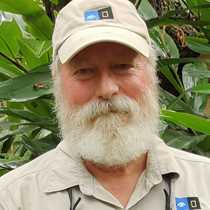Madeira
On Wednesday, we divided into groups so some of us could travel to Ribeiro Frio to take part in a strenuous seven-mile hike along one of the island’s irrigation channels, known as levadas. There are literally hundreds of miles of these manmade levadas on the island, which were built over the previous centuries to bring water from the highlands and wetter side to the agricultural fields of the lowlands. Today, they make wonderful hiking trails, because they have slight grades and provide us easy access to spectacular views. Getting so far into the countryside also gave us some good birdwatching.
The rest of us spent much of the day visiting the two world-famous gardens of Madeira. First we went to the national Botanical Gardens, set up on the grounds of a once private homestead, where we were almost overwhelmed by the profusion of flowering plants. The mild, maritime climate, and mineral-rich volcanic soil provides ideal conditions for an astounding number of plants from around the world. In addition to the many exotics seen here, several endemic Madeiran plants were also on display, even though they are now rare in the wild. We continued on to Quinta do Palheiro to enjoy the gardens laid out in the 18th century by Conde de Carvalhal. Some of the original plantation still survives, so we were able to stroll about and observe ancient camelia avenues, formal flower beds, topiaries, and immense trees. Many of us were inspired to work harder in our own gardens when we return home. This garden is now owned by the Blandy family (of wine fame), and coincidentally, we all went out to the Old Blandy Madeira Wine Lodge for dinner…where we were wined and dined and entertained with traditional fado and guitar music.
Thursday’s organized excursions took some of us far into the interior of the island for some spectacular views and overlooks in the highlands. We first visited an agricultural research compound and got a firsthand view of research and propagation of many of the commercial fruits grown on the island. One of the workers demonstrated the art of grafting, the importance of which was surprising to most of us. Madeira is a lush and verdant island, but we were able to see one region that was devastated by fire two years ago. It is slow to grow back. This route took us past several little towns nestled in the dramatic valleys, and we eventually reached the summit of Pico do Areeiro (5,937ft or 1818m) just in time to see the valleys below before clouds moved in to hide the view. From here, we drove to the town of Santana and stopped to look at some traditional little houses with thatched roofs, before enjoying lunch at a picturesque local hotel/restaurant before returning to Funchal. The rest of us spent the day exploring the Desertas Islands, a nature reserve consisting of three islands located about 15 miles southeast of Madeira. The islands are an important seabird sanctuary, and are also inhabited by the very rare monk seal, although none was seen today. Aboard our wooden vessel, Bonita da Madeira, we cruised along the coastline of the main island for views of the very colorful and dramatic volcanic sea cliffs and caves, before anchoring at Doca Bay and going ashore for a look around. A few people went swimming in the beautiful little bay. Even after the long day, a sizable group of us went back to Pico do Areeiro after dinner in order to hike out to the exposed slopes and, in the dark, listen to the Zino’s petrels calling as they returned to their nesting burrows.
On Friday, we all went to the delightful, but crowded, city market to view the impressive offerings of flowers, fruits, handicrafts, and fish (both dried and freshly caught). This gave us a chance to see the remarkable black scabbard fish, a deep sea animal which is the mainstay of the local fishing industry. Afterwards, some of us drove out to Ponto Sao Lourenco to go hiking on a great trail out into the rugged mountains and along cliff faces located at the southeastern end of the island. The scenery was superb (Figure A). The rest of us drove to the summit of Pico do Serrado (3,300 ft or 1,000 m), where we hoped for great views of Madeira's highest peaks, but encountered rain and clouds instead. Even so, we could still see the village of Curral das Freiras far below, a hamlet so remote that the Santa Clara Convent Nuns fled here to escape pirate raids in the 16th century. We passed through the vineyards of Estreito de Camara Lobos and could see the impressive cultivated terraces full of grape vines. After a decidedly carnivorous lunch, we returned to Funchal by way of Cabo Girao, the highest sea cliff in Europe, and the second highest in the world. This gave us yet another breathtaking view, which took in coastline below us, the picturesque city of Funchal, and the surrounding seas. Everyone returned to the Reid’s Palace Hotel for one last dinner, from where we watched the National Geographic Explorer sail into the harbor and tie up to the pier (Figure B). Everyone seemed eager to board her and begin new adventures with our voyage to the Azores.




